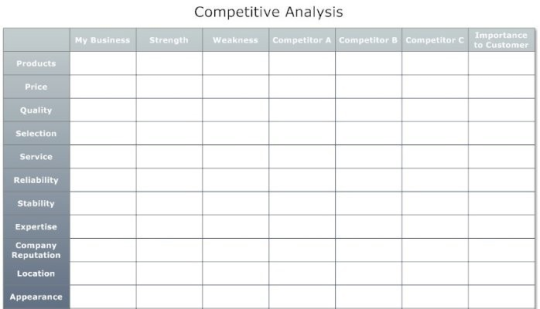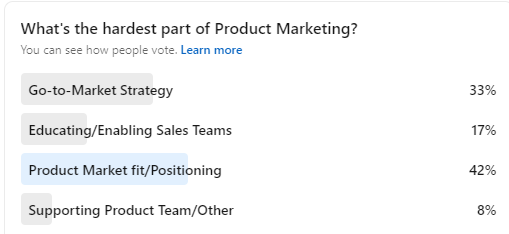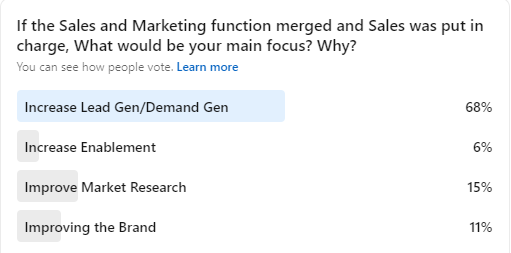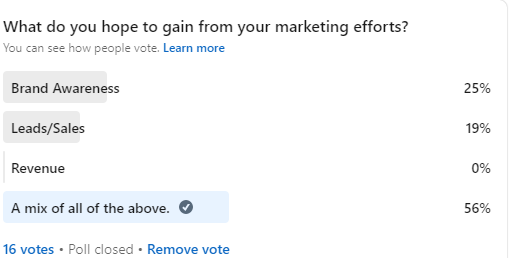Steps to Create Engaging Customer-Centered Sales & Marketing Presentations & Content-Based on Buyer Learning Styles
Creating content that engages customers is key.
Survey Results
I surveyed my LinkedIn Audience to ask which types of content help them to learn best and what type of content they value most.
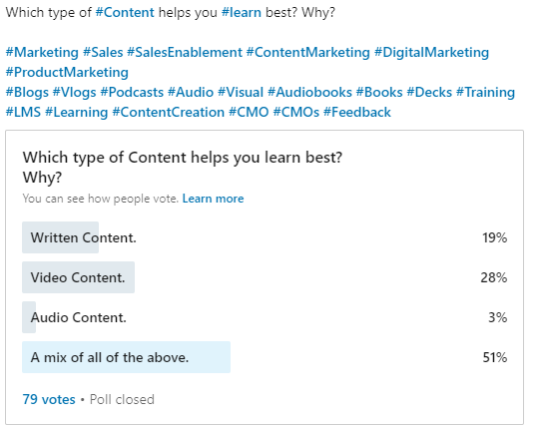
As you can see, people learn best from a mix of written, video, audio, and content formats.
Of the types of content, people want to read, many want to read industry insights, how-to, insights from conferences, and a mix of all of the above.
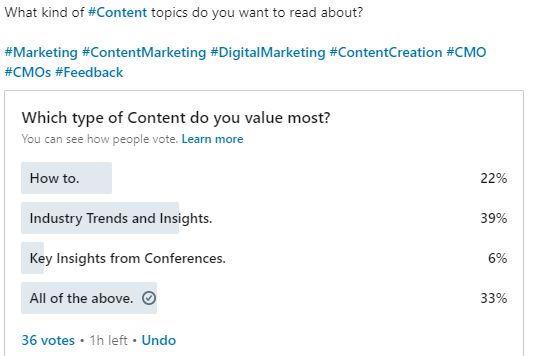
Based on my findings, I would recommend that content be:
1.Created and repurposed in multiple formats
2.Content is about industry insights, how-to, and insights from conferences
In other words, how do buyers learn best?
There are three learning styles, Visual, Auditory, and kinesthetic. 65 percent of learners are Visual but this is not everyone.
In the presentation below, I provide ideas and strategies to:
1.Collect information on your buyer’s learning style
2.Create presentations and content that will engage buyers with content that is optimized to their learning style making it more engaging
3. Create differentiated presentations and content for all learners when buyer learning styles are unknown
How to Customize Presentations & content to Buyer learning Styles
from
Content Creation
High-quality content created on a blog or newsletters has amazing potential to be shared, increasing readership. However, just creating content; sharing it in its original form on many channels multiple times will continue to yield diminishing results. Results are diminishing because Social Networks and the blog-sphere are bombarded with content. As a result, quality content will be overlooked. Now if you are reading this confused about what to do next, relax you are not alone. When I started blogging I thought the very same thing. Here is where content repurposing can help.
Creating Channels for Content
However, before content can be repurposed, channels to share the content must be established in addition to a blog and LinkedIn. These additional channels that you create will ensure that your content reaches a broader audience which increases opportunities for social sharing. I would start by creating accounts on other social networks such as Twitter, Facebook, Instagram, YouTube, and Slideshare.
Rewriting/Repurposing a Blog article
Blogs and Newsletters can be republished on additional platforms. For example, I publish my content on WordPress, Tumblr, Medium, LinkedIn, Anchor, YouTube, Facebook, and Instagram.
The Title of the republished blog
The first I would do is to change the wording of the title or put the title in the form of a question. Putting the title in the form of a question invites the audience to weigh in.
Your title should reflect the topic that you are writing about while being engaging to readers. Most people skim the headlines as they are overloaded with content.
Additional popular titles and content ideas include:
How to’s,
1.lists ex 7 ways to _______
2.Ask Me Anything/ Questions and Answers
3.What I learned
4.Trends in
5.Newsjacking a story with your analysis
6 Coverage of industry events sharing trends and insights
7.Interviews with Industry leaders
Calls to Action
A great call to action would be: feel free to comment, or ask a question of the reader at the end of the post. Other calls to action could be a link to a website, landing page, content, etc… using words like learn more, read more, see a demo, contact us to name a few.
By having a call to action to comment, readers are more likely to start a discussion and share the content. It is important to talk with your audience and not at them.
SEO tags Keywords
Make sure to pick keywords that reflect your topic. LinkedIn, WordPress, and Tumblr allow users to include as many as they would like while Medium’s platform allows only five.
Images
Make sure when you upload an image that it reflects what your post is about.
About the Author section
I would add an about the author section at the bottom of each article. This is another great way to showcase the author’s expertise; incorporating a call to action such as: see how we can help or click here to sign up for a free demo.
Repurposing Formats beyond a blog
The contents of the article can be put into different formats such as a PowerPoint, YouTube video, ebook, whitepaper, newsletter, publication, and Podcast. All of these formats can be uploaded to SlideShare. The article can be published to LinkedIn’s publishing platform as well. Your article can also be written having presentations and videos embedded in the article itself. Content can be cross-promoted across content and social channels, in calls to action; embedded, and in links. There are endless ways to repurpose content.
The overall content strategy should be based on how your customers learn and the types and format of content based on their wants and needs.
Another key element to creating both customer-centered presentations and digital content is knowledge of buyer learning styles.
Customer-Centered Sales & Marketing Presentations
Developing Your Presentation
When you start to develop your presentation, it is important to know your prospects’ business. It is imperative to know your products and services; specifically how the prospect can benefit from them. As a salesperson, it is your responsibility to uncover what the prospects’ needs are. The next thing that has to be done is to know how your company and your products compare to the competition.
How do buyers learn best?
There are three learning styles, Visual, Auditory, and kinesthetic. 65 percent of learners are Visual but this is not everyone.
How to Customize Presentations & content to Buyer learning Styles
from
Product Knowledge
Product knowledge is a must. (You should also know what motivates the prospect to buy.) Based on whom your prospect is currently using as a supplier, you can use this information to show how you are better than whom they are currently using. Only after you have done this research are you ready to move forward.
Preventing Objections
Make sure the sales and marketing content in your presentation is thorough and can answer as many questions as possible. Your goal is to prevent objections and questions by prospects by covering them in your presentation.
Testimonials
Make sure to have testimonials from loyal customers with you. (Many times prospects will ask who else you have worked with before considering you.) Make sure to include product specifications and an ROI analysis if the product you are selling is a big-ticket item.
Practice
You should also practice your presentation to make sure it sounds polished. Get your manager and colleagues to watch your presentation and critique it. Filming yourself and watching your presentation will help you improve.
Remember to not be nervous and to convey your enthusiasm through your tone of voice and body language. Do not cross your arms and make sure to make eye contact with your prospect. Make sure to speak slowly, clearly, and in a loud voice.
Delivering Your Presentation
Your presentation should include a demonstration of your product whenever possible. You should coordinate with your prospect to make sure there is a projector available if you are going to use visual aids. Also if you are going to use PowerPoint or any visual aids, make sure to use them only when necessary to supplement your presentation. Remember you are conducting the presentation, not the visual aids.
Customer/Prospect Engagement: Making the Presentation Customer Centered
Make it a point to get prospects involved in your presentation. It is about engaging your prospect. Have them plug things in, play with the buttons, etc… You want the prospect to develop an attachment with your product. Presenting in a way that prospects feel comfortable learning and processing information.
How do buyers learn best?
There are three learning styles, Visual, Auditory, and kinesthetic. 65 percent of learners are Visual but this is not everyone.
Handling Objections & Stalls from Prospects
In sales, everyone has to be able to overcome objections to be successful. The best way to overcome objections is to prevent them. This can be done by providing a thorough sales presentation that covers all the information about your products and services. Also, you must address any questions the prospect has immediately. However, objections will come up from time to time. Some of these objections are real buying signals and others are just stalls to put you off. As a Salesperson, you need to be able to tell the difference.
1.I am happy with my current supplier.
When you call on a prospect they say we are happy with our current supplier, this can mean one of two things. The first is that they are truly happy and the second is that they want you to get lost. (A stall) You need to be able to tell the difference. You should be able to tell by a prospect’s body language and level of attention.
If it is the first scenario, you should find out what supplier they currently use. When the prospect tells you it is your job to demonstrate how you are better. Once you feel that you have demonstrated how you are better, ask for a commitment or small order. By asking for small order, you provide the prospect an opportunity to take a chance on you with minimal risk. I have had a lot of success with this approach.
If the scenario is the second one, the prospect will not provide you with any information or say that they deal with a company or person for 20 years and they do not want to change. In this case, I would still ask for the order. Should the prospect say he is not interested again, I would thank them for their time and leave. You should call on this prospect a few more times and then only call on them every two months. You need to focus your time on prospects that are receptive to you and your offering.
2.I want to think it over.
When you hear this, what the prospect is saying is I am interested but I am not convinced. You should ask the prospect what specifically about this offer do you want to think over? Your goal here is to uncover the real objection. If the prospect gives you a specific answer, you are in business. Address the objection and ask a closing question. Say if I can handle XYZ, is there any reason why you would not purchase this product. Should the prospect say, no you covered everything, this means that they are either stalling, not interested in your offering, or will not tell you the real issue they have with your product. If this is the case, ask when they plan on making a decision and follow up with them in that time frame.
3. I need to consult another party.
This can be a stall to put you off. You will need to determine this by the prospect’s body language and the level of attention you receive. When the prospect tells you this, you should ask for a meeting with the prospect and the person they need to consult. Should the prospect agree to this, you have a chance. If they will not agree to a meeting, it is a stall and they are not interested in your offering. However, I would still call on them a few more times. If you have no success, call on them every two months.
4. I am not the Decision-Maker. — The Columbo Technique
During some cold calls to dental offices, I was not able to obtain the information that I needed to overcome prospect objections. This occurred because the person I was speaking to was not the decision-maker. As a result, they were reluctant to talk for fear that they would say the wrong things or give away too much information on their bosses’ business. Despite their reluctance, I would continue to talk with them, build rapport and bond. I would ask to speak to the decision-maker but many times they were not in the office, or the person I was speaking with would not want to disturb them for fear of getting reamed out when I left the office.
When this was the case, I would use the Columbo technique to get the information that I needed. I would turn to leave the office, put my hand on the doorknob and ask who their supplier was or when I could catch the boss. Usually, the person I was speaking with would provide me with a lot of information about the prospect. Even more, than I expected! This is because the person that I was speaking with put their guard down. After all, they thought I was leaving the office so one last question didn’t seem so bad.
During other cold calls, I was able to speak to the decision-maker. I would build rapport with them and try to obtain as much information as I could to overcome their objections. Many times the prospect would be reluctant to give me information; stating that they were happy with their supplier or they were too busy to speak to me. When they used the supplier objection, I would employ the Columbo technique; turn to leave and ask who their supplier was. Many times they would tell me and I would ask them for a few moments of their time to show how my products were better. I would get the time and close the prospect on giving me a trial order. I developed some of my best customers this way. Other times, I was able to obtain a follow-up appointment with the prospect.
The key to the Columbo technique is to get prospects talking. Even if it’s about things not related to their business at first. You want to make them comfortable talking with you. Next, you want to save the question you want to know for the end of the conversation because the prospect will most likely answer it thinking you are going to leave their office. In other words, their guard is down.
The Columbo technique is a great way to close sales and obtain information.
- Your price is too high.
Emphasize the quality of your product along with the level of service you will provide. Next, you should demonstrate to the prospect how your offering’s total cost is less than the competitors over the life of the product. This is when you can bring up the competition showing how your products are superior in terms of product features and benefits using market research. Testimonials or social proof from loyal customers can also help. By taking these steps you demonstrate that your product is valuable and increase your chances of making the sale. (Provided this is the real objection.)
5. We spent our budget.
If they say the money is not the budget, ask If I can offer delayed billing or a payment plan would you be able to take delivery? If the person needs approval from another person, ask to present your product to that individual with your prospect’s endorsement. Should the company want and need your product, they will find a way to pay for it.
6. I had a bad experience with your company.
I would apologize to the prospect about the experience. Tell them you are the new rep and that you will not let anything bad happen on your watch. Ask them to give you a chance. This will not work all of the time.
7. Call me After the Holidays.
During the holiday season, many people are in holiday and party shopping mode. from Black Friday, Cyber Monday, and many other things. Also, everyone is thinking about going to parties. So the last thing on your customer’s and prospects’ minds is to make a year-end purchase; unless they receive a year-end tax advantage. As a sales rep, you are under pressure to close deals so you can earn that bonus. Unless your customer is in a buying mood, you are going to hear the objection “call me after the holidays”. If you have done business with this customer, you will have an easier time than if you are making a cold call.
To combat this objection. You have to attempt to get around this objection. If your offer is time-sensitive or if you can provide a break on pricing or payment through a special promotion for example no payments for 3 months; make your customer aware of them. However, at this time of the year, you will get customers and prospects who just don’t want to deal with you and your offering. As a sales rep, it is your job to be able to tell if the customer and prospect are telling you the truth. In other words, you need to qualify their objections. This means following up with every customer and prospect even when things look bleak.
Should your customers and prospects insist that call you after the holidays, I would find out which holiday they mean. Next, I would pin them down to a specific day and time to call back. I recommend sending your customers and prospects a holiday card with a little note reminding them about the appointment; stating how you look forward to speaking with them on the specific date and time. Once this time comes, I would hold them to their promise. Deliver your presentation and ask for the business.
Post Presentation Follow up
After you leave, be sure to follow up with a hand-written thank you note. Even if you did not make the sale, it is important to be grateful to the prospect for their time. You want to stay in front of the prospect because things always change. There is always a next time!
How do you create sales and marketing content and presentations?
Share your strategy and ideas in the comments.
Additional places to find my content and blog
WordPress: http://dangalante.me/
Tumblr: http://www.askdangalante.com/
LinkedIn: https://www.linkedin.com/today/author/DanGalante
Medium https://medium.com/@DanGalante
YouTube https://www.youtube.com/trendsettingsm
Anchor https://anchor.fm/dangalante
About Me
I’m a Strategic Marketer with Field Sales, Sales Enablement, Content Creation, and, Classroom Teacher/Trainer skill-sets using Marketing to drive Sales/Growth.
As a Marketer, I’ve worked with Start-Ups, a Political Campaign, and a Digital Marketing Conference. I’m certified in Inbound Marketing with classes in Marketing, Product Management, Product Marketing, SEO, SEM.
Before teaching, I was an Outside Sales and Marketing Rep. selling and marketing dental products to Dentists using consultative selling, trade show marketing, field marketing, and market research.
I publish Sales, Marketing & Social Media Today a blog covering industry events and trends.
Articles and insights have been featured, mentioned, and, referenced in:
Tractica in the News
The Future of AI
https://medium.com/@DanGalante/the-future-of-ai-insights-from-the-ai-summit-ab6267eca70b
Digital Marketing World Forum
Voice Summit
Compilation: Our Favorite Post-VOICE Coverage So Far
https://www.voicesummit.ai/blog/compilation-our-favorite-post-voice-coverage
Engage Bay
7 Steps to Align your Marketing Automation Strategy
https://www.engagebay.com/blog/marketing-automation-strategy/
Relay 42
The Role of Technology in Customer-Centricity
https://relay42.com/resources/blog/the-role-of-technology-in-customer-centricity
Databox
How to Improve Marketing and Sales Alignment (Gave background)
https://databox.com/how-to-improve-sales-marketing-alignment
Onalytica
Named as a Top STEM Influencer for EdTech and Education Industry Insights.
http://www.onalytica.com/blog/posts/stem-top-influencers-brands-publications/
The Arizona Republic
http://yourbusiness.azcentral.com/handle-top-10-sme-sales-objections-24845.html
Twitter Ads Blog
https://blog.twitter.com/2014/how-smartphone-users-engage-on-twitter-three-key-findings
Paper.li’s Wall Of Fame via Scoop.it
http://www.scoop.it/t/all-things-paper-li/?tag=Dan+Galante
I’ve been honored for my Social Profiles
•LinkedIn SSI Score in the Top 1%
•SlideShare for being in the top 5% of profiles viewed in 2014
•LinkedIn Profile was in the top 1% of profiles viewed out of 200 million members in 2012
I’m seeking a full-time role in:
Inbound Marketing, Digital Marketing, Content Marketing, Product Marketing, Demand Generation, Social Media Marketing, Sales Enablement Enablement, Sales Strategy, Marketing Strategy, Employer Branding, Recruitment Marketing. Reach out to start a conversation on LinkedIn or email me at dan@dangalante.com

